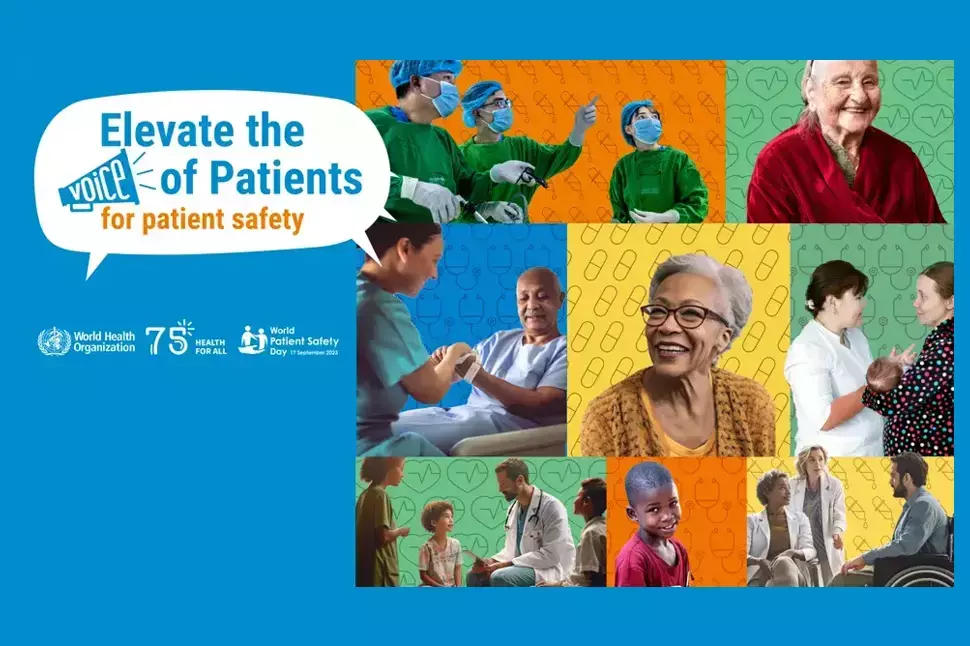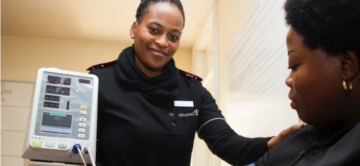In honor of World Health Organization World Patient Safety Day 2023, the Patient Safety Movement Foundation hosted a webinar dedicated to the theme of “Empowering Patients.” Chaired by Helen Haskell MS, president of the nonprofit patient organizations Mothers Against Medical Error and Consumers Advancing Patient Safety, it featured insights from the following speakers:
Neelam Dhingra, MD: the head of the World Health Organization Transformative Flagship Initiative “A Decade of Patient Safety 2021-2030” Geneva, Switzerland
Angela Coulter, PhD: a UK-based health policy analyst, who chairs the board of trustees at the Picker Institute Europe, a healthcare charity which researches patient and staff experience of care.
Sue Robins, BA: a Canadian healthcare activist who has held family leadership positions with the B.C. Children’s Hospital and the Stollery Children’s Hospital.
Maren Batalden, MD, MPH: the Chief Quality Officer at the Cambridge Health Alliance, an integrated community health system serving seven towns in metro-northwest Boston, Massachusetts, and an Assistant Professor of Medicine at Harvard Medical School.
The Patient Safety Movement Foundation would like to express gratitude to all speakers for sharing their views on this vital aspect of patient safety.
Five Ways to Empower Patients and Improve Patient Engagement
Authors: Patient Safety Movement Foundation, World Health Organizations, Neelam Dhingra MD, Helen Haskell MS, Maren Batalden MD MPH, Angela Coulter PhD, and Sue Robins BA.
Patient engagement is one of the most critical yet often neglected strategies for improving safety in our healthcare systems. While some hospitals may be slow to invest in engaging patients and their families, studies have shown that if the perspectives of patients are involved in their care, this can reduce the likelihood of harm by up to 15 percent.
In real terms, that figure amounts to numerous lives saved every year, along with billions of dollars which would have been wasted on unnecessary procedures and lawsuits and can instead be invested in better treatments and care.
As a result, the World Health Organization has selected ‘Engaging patients for patient safety,’ as the dedicated theme for World Patient Safety Day 2023.
“It’s well recognised through evidence that when patients are treated as partners in their care, significant gains are made in safety, in patient satisfaction, and their health outcomes are also very improved,” says Dhingra. “When we look at what actually is required to achieve safer care, we require the patients are fully informed, they are involved, and they are treated as full equal partners in their own care, in the care of the system, in improving the safety of the system, and also looking into the planning and governance of the organization.”
Coulter says that if incorporated by the system, patients can be important promoters of safety, and become active and valuable participants in decision-making with clinicians. “They can contribute to making sure that the medicine prescribed is right for them,” she says. “And they can provide feedback and advocacy so that their experiences can be used to improve care for other patients.”
Quality and safety advocates feel that the theme of this year’s World Patient Safety Day is particularly imperative as much of the previous progress that had been made in patient engagement was actively impeded by the Covid-19 pandemic.
“At least in Canada, I feel like it fell off a cliff,” says Robins. “That’s the first thing that was thrown out, patient engagement.”
Robins recently co-authored a paper in the British Medical Journal (BMJ) with Miles Sibley, Director of the Patient Experience Library in the UK, arguing that more needs to be done in the wake of the pandemic to recognize and value families as partners in patient care.
“I’m optimistic,” says Coulter. “Lots of clinicians are now talking about patient engagement as a central part of healthcare, but I do worry that we may have taken a step back for understandable but regrettable reasons. During the pandemic everybody in healthcare was working flat out to counter a disaster. And it was therefore quite easy to make excuses for not engaging people.”
So how can healthcare systems take action and work to elevate the voices of patients? Here are five key pillars of patient engagement.
1. Utilizing Patient Feedback
As part of its Global Patient Safety Action Plan, the World Health Organization has taken numerous steps towards utilizing the perspectives of patients and families who have been harmed in healthcare, in order to make the healthcare system a safer place. From the formation of the Patients for Patient Safety Network to a proposed patient safety rights charter, the development of a patient storytelling toolkit, and growing the number of patient advocates and champions, an increasing array of initiatives are underway.
“We truly draw our inspiration to work in patient safety from people who have suffered harm due to the weaknesses in the healthcare system,” says Dhingra. “Patients and families, I truly believe are an untapped resource for patient safety. They should be involved in every level of the healthcare system.”
Batalden was one of the original promoters of the now-popular term for empowering patients by working actively with them as equals, the concept of “co-production of healthcare”. She says that she was inspired to do so, in part, as a response to the fact that quality and safety movements borrow a lot of their tools and logic from the world of manufacturing. “Making health is really different from making cars or shoes or electricity,” she says. “It’s incredibly intimate, it always requires a partnership. Whatever our natural inclinations, we patients and health professionals can’t opt out of “co-producing” health outcomes.”
This is currently recognized to varying extents by healthcare systems globally. Right now, a number of countries around the world have pharmacovigilance reporting systems which enable patients to report adverse drug reactions. In the UK, an independent non-profit feedback platform called Care Opinion allows patients to submit stories about their experiences which are then shared with the relevant organizations.
However, Robins says that the latter ability is relatively rare. “I wish there was some venue for patients in Canada to share what their healthcare experience is like, and then our hospitals adjust and make themselves better based on that,” she says. “We don’t have any kind of accountability like that, and I think that that’s a real shame.”
Coulter believes that even in the UK, patient-collected feedback could be utilized far more widely than it currently is. She feels that the optimal future would see information gathered through both patient and staff surveys used in tandem to improve healthcare systems. “Patients can help with infection control initiatives,” she says. “They can remind clinicians if they see problems with, for example hand washing.”
One way in which feedback collection could be accelerated is through the many digital platforms and apps which have arisen in the last three years through the pandemic. “There’s a silver lining for patient engagement and patient empowered that can’t be underestimated,” says Batalden. “These are tools that we have at our disposal for trying to engage patients more effectively in safety and quality.”
2. Information As a Tool for Patient Empowerment
During Covid-19, much of the world became armchair experts overnight in previously arcane and specialized topics of healthcare and epidemiology, from viral transmission rates to antibody testing.
Coulter says that this illustrates the enormous thirst for health information amongst the general public, something which she believes has been underestimated by healthcare professionals in the past. “The pandemic showed that if you design information for the public, the public will lap it up,” she says.
As a result, she believes that allowing patients to understand the value they can provide to the healthcare system, by educating them about their medication and treatment options and enabling them to become part of a shared decision-making process, can make them more empowered.
“To get patients to promote their own healthcare and indeed quality of care, you’ve got to give them the basic building blocks,” she says. “It’s something I think health systems need to understand better and invest in. It’s about understanding benefits, risks, uncertainties about using those to come to an informed decision about what’s best for you.”
While many health systems are now straddled with systemic problems such as long waiting times and strapped budgets, Coulter feels that it remains imperative for services to provide these resources, if we are to move healthcare forwards.
“It looks to some people as if it’s an extra that’s not essential,” she says. “I would say it’s absolutely at the core of good healthcare and we can’t do without it.”
But it is not only information about diagnostic and treatment options which would benefit patients, but more granular details about the way the healthcare system works. “People can’t actually be effective advocates for themselves if they don’t understand the next steps in the process or how the pieces come together,” says Batalden.
3. Furthering Access to Medical Records
Some high-income countries have made considerable strides in enabling patients to access their own medical records. In the United States, a federal law mandated all US healthcare providers to allow patients to access all the information within their electronic medical records free of charge, while other nations have also taken steps to making medical information available.
But as the BMJ described last year, not everyone can access their health records online, a disparity which many feel needs to be addressed.
Batalden vividly remembers the trepidation within the US healthcare community about the prospect of allowing patients to access their records. “Before it was mandated people were very nervous,” she says. “Oh my goodness, what would happen if we let patients read their charts? They might inundate us with questions, and we couldn’t possibly attend because we’re so busy. Or they might see that we made a mistake and lose their confidence in us. But in fact, it has made things easier for people.”
In reality, Batalden notes that after the mandate to share medical records with patients, providers in her health system did not experience the anticipated difficulty; in fact, many appreciate the way that empowering patients with direct access to the record enables them to act independently in support of their health and strengthens safety by ensuring a second set of eyes on the documentation.
But the benefits of allowing patients to access their records stretch far beyond spotting errors. Coulter argues that it helps to level out the inequal power dynamic between patients and healthcare providers.
“Information is power,” she says. “If you hold back information about the individual, you’re exerting a kind of power over them, and makes them feel like the least important person in the doctor-patient relationship. It’s an example of the power shift that’s needed if we’re going to feel engaged and in control of our health.”
4. Promoting Patient Engagement by Addressing Power Differentials
But power differentials are not only about access to medical records. Robins says that when she speaks to medical students, she asks them to recognize the power that they hold over the patient in a hospital room. It is these inequities which often hinder patient engagement and prevent patients from speaking up when they are concerned.
Many patients are often particularly vulnerable in that situation because of their illness, but also other cultural and socioeconomic barriers. “About half of our patients speak English as a first language,” says Batalden. “And there are so many additional layers that prevent people speaking up and being partners in their healthcare – age, poverty, education, cultural experiences, all of that.”
Robins points to the importance of taking compassion into patient interactions, views which have previously been referenced in the scientific literature.
“I ask the students to think about the situation when you’re sitting in a room, you’ve got a paper gown on, you’re already feeling vulnerable, sick, stressed, you’re half dressed, and the doctor just bursts in and starts talking,” she says. “I always say this is a huge power thing – you have to slow down.”
She is concerned that the increasing pushes for efficiency within healthcare systems simply act to worsen this power differential, with negative impacts on quality, patient engagement and ultimately safety. “As a patient, I feel rushed in those interactions, and I don’t feel like they’re making the time to listen to me,” she says. “And then my agenda, the reason I’m there, isn’t even on the table. It comes from them, it doesn’t come from me. There’s lots going on in that initial interaction in the clinic that we could look at and start working on today.”
Coulter acknowledges that health professionals are always busy and conscious of the many other patients in the waiting room, but she says that patients are very cognisant of this too. “Very few of them actually want to take up the doctor’s time, and that can be a barrier to telling them what the real problem is,” she says.
She feels that the way the consultation is structured within medical training, often prevents the clinician from fully listening to patients, which ironically leads to greater inefficiencies. “Sometimes spending a little bit more time at the beginning listening, making sure that you’re addressing the real problem, might even reduce the number of follow-up consultations,” she says.
5. Building Trust
Canada’s decentralized, universal, publicly funded health system known as Canadian Medicare, is widely described as a source of national pride. However, Robins says that the system is too focused on efficiency and the numbers of people who have been treated, rather than the quality of the patient and staff experience.
“Efficiency reminds me of fast fashion,” she says. “Our healthcare, when built like that, doesn’t last because we don’t make the time to listen to what patients have to say. We push people through, and they end up in emergency later.”
Instead, she believes that health systems should focus more on the final pillar of patient engagement – building trust with patients – and resoundingly disputes the notion that doctors lack the necessary time required to do this.
“There’s a great book called Compassionomics that talks about how much time it takes to show compassion back to patients,” she says. “And it’s like 30 seconds, it actually does not take more time. Healthcare is about human beings, it’s about relationships and I fear that we’ve drifted from that.”
Batalden says that the beneficial impact of creating a more human connection between healthcare personnel and patients has even been shown in data. “We discovered, for example, that we could reduce the no-show rate for first appointments dramatically if we actually gave people at the time of referral, a little one-page introduction to the person they were going to meet with a photograph and a little description of who they were,” she says.
But to really make a lasting difference in building trust and promoting patient safety, Dhingra says that it is up to government institutions and policymakers around to take measures which ensure the active involvement of patients and their families in plans for developing safer and more resilient healthcare systems in future.
“One of the indicators which we have asked countries to report on, is how many hospitals have patient representatives on the governing boards? A recent survey – which we concluded a couple of months back – shows that as of now, only 13 out of the 110 countries that reported actually have the majority of their hospitals having patient representatives on the governing boards. So we have a long way to go, and I call for action of all stakeholders to put in efforts for meaningful patient and family engagement for patient safety.”





